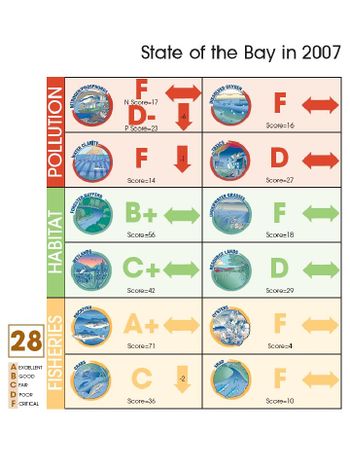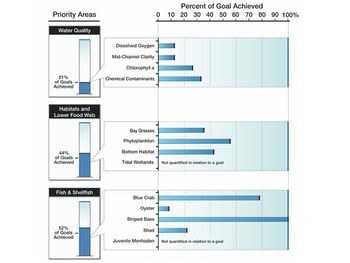Chesepeake Bay Program
Efforts at integrated management began in the Chesapeake Bay region in the 1970s after decades of steadily declining water quality. The Chesapeake Bay Program evolved from a well-funded scientific study to a national model for a participatory ecosystem approach that is very popular at the community level. Hallmarks of the Program include use of the best available science, consensus driven decision-making, strong public involvement in planning and implementation, adaptation of specific management goals, flexible methods for states to meet federal requirements, and significant long-term federal and state funding. Despite large and sustained investments and some notable environmental improvements, the overall health of the bay remains poor.
Contents
Characterization of the System
The Chesapeake Bay is the United State’s largest and most biologically productive estuary. The Chesapeake lies along the nation’s eastern seaboard and its watershed includes all or portions of six states: Delaware, Maryland, New York, Pennsylvania, Virginia, and West Virginia. About 15 million people live along the shore of the bay or its tributaries. Most of the population is concentrated in two large urban centres: Baltimore and Washington, DC. The watershed extends over about 172,000 km2, and the area of the Bay itself is 6,475 km2. Thus the watershed-to-estuary ratio is very high. The large watershed funnels in nutrient-rich freshwater from six tributaries. Nutrients and other non-point source pollution from his large area enters the bay as run off, and is then concentrated into the relatively narrow bottle neck of the estuary. Much of the Chesapeake’s watershed is forest and agricultural land that contains some of the highest concentrations of livestock and intensive cropping in the United States.
The Chesapeake is renowned for its fishery production, recreational opportunities, and high value waterfront property. The two salient characteristics of the Chesapeake are its shallowness—the average depth is seven meters—and its very large watershed. This shallowness creates conditions where sunlight can penetrate to the bottom, allowing for the growth of seagrasses and abundant bottom-dwelling communities.
How the Program Has Evolved
By 1970, significant losses in fishery resources, the disappearance of seagrasses, and the decline in oyster harvests all appeared to be linked to the very visible impacts of water pollution. It had been assumed that the construction of sewage treatment plants would solve these problems. Instead, the classic evidence of euthrophic conditions was becoming more prevalent each summer. In 1974, a group of legislators from the bay region were successful in convincing Congress to provide $27 million to the U.S. Environmental Protection Agency (EPA) to undertake a five-year study of the Chesapeake. The initial findings scientific studies were controversial and inconclusive. In response to the inability of the scientists to agree on recommendations to address the issues, EPA established a resource users group in 1981 that succeeded in crystallizing the issues. It recommended that the program focus its efforts upon nutrient over-enrichment, pollution by toxics and the dwindling abundance of seagrasses. The program’s early decision to involve non-scientists representing important stakeholders to identify policy choices was essential in turning around the image of the project from that of a well-funded research effort to a practical restoration effort. This time period coincided with the passage of the Federal Clean Water Act which mandated reductions in point sources of pollution. Section 117 of the Act provided significant funding for developing the Chesapeake Bay Program.
In 1983, spurred by mounting public concern, the governors of states bordering the bay, the mayor of Washington and the administrator of the EPA came together and negotiated the first Chesapeake Bay Agreement. This was a formal commitment by the states to participate in a regional decision making partnership, to commit to specific goals for restoring the bay’s living resources, and to a sustained program of water quality monitoring.
The second Chesapeake Bay Agreement was signed in 1987. This was a specific plan of action that set forth a comprehensive set of 29 commitments. Its central goal was to achieve a 40 percent reduction in nitrogen loadings by the year 2000, using 1985 as the base year. The 1987 agreement became the model for the quantitative and time-limited goals that have been the keystone of the program’s approach to ecosystem governance ever since.
The 1992 amendments to the 1987 Agreement called for the allocation of specific loads to each of the major tributary systems, and for the development of the strategies that would demonstrate how each tributary would achieve a 40 percent reduction by 2000 and sustain those nitrogen levels thereafter. However, this goal was not met—even though major reductions were achieved for point sources of pollution. The difficulties in achieving nutrient reduction goals lay in the unexpectedly large contributions of nonpoint sources. Controlling these dispersed sources of nutrients and other contaminants require major changes in land use, in the management of urban areas and in agricultural practices. Resent research has demonstrated that a major source of nutrients is atmospheric contamination generated within an “airshed” that is considerably larger than the Bay’s watershed. Figure 2 for the State of the Bay Report Card highlights the continued pollutant loads, habitat degradation and low fish stocks for selected species. Figure 3 highlights the progress made towards the goals.
Chesapeake 2000 is the most recent statement of the program’s goals. It is the result of the program setting increasingly more ambitious targets as it has learned more about the issues. While the 1987 Bay Agreement set the first quantitative target for nitrogen only, Chesapeake 2000 sets a more stringent target for nitrogen while also setting targets with timeframes for achievements on all the issues.
Program Achievements
The Program made major investments in public education and this has contributed to sustained popular support. Focusing efforts on unambiguous goals signed by top-level elected state representatives and national government officials avoided difficulties associated with negotiating all-encompassing and detailed plans. Providing freedom to regional and local bodies to come up with their own solutions and plans to achieving the commonly agreed upon goals empowered a wide variety of groups including local communities and non-governmental organisations, and encouraged them to make a deep commitment, take practical steps and implement innovative ideas.
The Program has catalysed a number of environmental achievements. These include increase in the quality of fish spawning habitats that have produced improvements in the abundance of such important species as stripped bass and shad. By 1999, 476 miles of streamside forests had been restored. Although the goals have not been achieved for nutrient reduction, phosphorus and nitrogen loads have declined since 1988. Turbidity has also declined, but algal blooms continue to occur in the once-clear waters. Oysters, which used to filter the Bay’s entire water volume in less than a week, are still only about 1% of the 1950’s population level. Blue crabs remain a threatened fishery.


The Governance Structure of the Program
The Chesapeake Bay Program’s management structure has evolved significantly. The initial management structure during the research and issue identification stage provided for a Policy Advisory Committee that oversaw the program and the activities of committees. Following the 1983 agreement, the Policy Advisory Committee was replaced by a higher level Executive Council composed of representatives of the states, the EPA. The 1987 Agreement further elevated the Executive Council so that these states are represented by their governors—the highest elected state official. The Council has met annually since 1987 and operates through directives, agreements and amendments. It defines the goals and the program’s key management procedures.
The Implementation Committee is composed of state representatives, the Chesapeake Bay Commission, the EPA, and the 10 federal and state agencies that contribute most directly to the program.
Through the Science and Technical Advisory Committee (STAC) the science community has played an essential role in identifying the issues that are most critical to the functioning of a healthy estuary and to bringing new insights into the processes of debate, evaluation and adaptation [3]. The STAC establishes peer review systems for all bay program funded competitive research, reviews and comments on all proposed budget items, holds symposia and carries out technical reviews of key scientific issues.
The Citizens Advisory Committee has 23 members, with representatives from agriculture, business, conservation, industry, and civic groups. Since 1984, this group has provided a non-governmental perspective on the bay cleanup effort and on how bay program policies affect citizens who live and work in the Chesapeake Bay watershed.
The program’s strategy of focusing its efforts on unambiguous agreements signed by top-level elected state representatives and federal government officials has avoided the difficulties that come with negotiating the more usual and all-encompassing and detailed plans. The strategy has been to leave each state the freedom to decide how it will make its commitment to achieving each goal. This, in turn, encourages an atmosphere of competition and empowers local communities, NGOs and a wide diversity of groups and organizations to come forward with their own ideas and commitments.
A highly critical report to Congress, issued by the United States Government Accountability Office in 2005, has questioned the success and effectiveness of the Program. This report asserts that the Bay Program lacks an integrated approach for assessing progress towards its stated goals, and states that the Bay Program’s reports do not realistically communicate the condition of the Bay despite direct and indirect state and federal funding that approaches $6 billion over the ten year period of 1995 to 2004. By 2008 there is evidence that these recommendations have been taken to heart. An easily navigable website provides a host of information and the new “Eco-check” [4] Bay report cards provide a new approach to tracking and reporting the health of waterways at both local and regional scales.” These reports apply a Bay Habitat Health Index to present a score, or “grade” (A through F), for the health of each Bay’s tributary. The 2007 Report Cards awarded scores for the tributaries and main stem of the Bay that range between B and D-. This new approach reaffirms the enormous difficulty of restoring lost qualities in a severely impacted estuarine ecosystem where nonpoint sources of contaminants dominate.
See also
Internal Links
- Channel Islands National Marine Sanctuary – Case Study
- US Coastal Zone Management Program
- Coastal Barrier Resources System
- Overview of Coastal Habitat Protection and Restoration in the United States
- Essential Fish Habitat
- Clean Water Act
- US National Estuary Program
- US National Estuarine Research Reserve System
- US National Marine Sanctuaries
- US National Wildlife Refuge System
- Rhode Island Salt Pond Special Area Management Plan – Case Study
- US Sea Grant College Program
- Tampa Bay Estuary Program
- US Army Corps of Engineers’ Coastal Programs
External Links
- Case study brochure of how the Chesapeake Bay is addressing Climate Change https://www.chesapeakebay.net/documents/climchangereport.pdf
- The Governance Of Large Ecosystems at the Regional Scale: Analysis of the Strategies and Outcomes of Long-Term Programs http://www.crc.uri.edu/download/GovLargeEcosystems_OlsenNickerson.pdf
- Chesapeake Bay Program website http://www.chesapeakebay.net
- Alliance for the Chesapeake Bay https://www.allianceforthebay.org/
- Chesapeake Bay Commission https://www.chesbay.us/
- Chesapeake Research Consortium https://chesapeake.org/
- Chesapeake Bay Foundation http://www.cbf.org/
Further Reading
- Inquiry in a Culture of Consensus: Science and Management for the Chesapeake Bay. Matuszeski, William. 2008. UM-SG-CP-2008-01.
- Hennessey, TM. 1994. Governance and adaptive management for estuarine ecosystems: The case of Chesapeake Bay Coastal Management. Journal of Coastal Management. Vol. 22, no. 2, pp. 119-145. 1994.
References
- ↑ Chesapeake Bay Foundation - https://www.cbf.org/
- ↑ http://www.chesapeakebay.net/status_bayhealth.aspx?menuitem=15045
- ↑ GESAMP (IMO/FAO/UNESCO-IOC/WMO/WHO/IAEA/UN/UNEP Joint Group of Experts on the Scientific Aspects of Marine Environmental Protection). 1996. The contributions of science to coastal zone management. Rep.Stud.GESAMP, (61):66 p. http://www.gesamp.org/site/assets/files/1239/the-contributions-of-science-to-integrated-coastal-management-en.pdf
- ↑ http://www.eco-check.org/reportcard/chesapeake/2007/indicators/bay_health_index/
Please note that others may also have edited the contents of this article.
|
